Paikauhale, Tau Scorpii (τ Sco), is a massive blue main sequence star located approximately 470 light-years away in the constellation Scorpius. With an apparent magnitude of 2.82, it is the ninth brightest in Scorpius. It is one of the two stars flanking the bright Antares.
Like many other bright stars in the area, Tau Scorpii is a supernova candidate. It is one of the stars that form the Fish Hook, a prominent southern asterism that corresponds to the celestial Scorpion’s body and tail.
Star type
Tau Scorpii is a hot blue main sequence star of the spectral type B0 V. It has a mass of 14.5 – 15 solar masses and a radius 6.42 times that of the Sun. With an effective temperature of 28,862 K, it is 25,000 times more luminous than the Sun.
The star has an estimated age of only 5.22 million years. It spins at 24 km/s, taking 41 days to complete a rotation. It may in fact be rotating much more rapidly but if its axis of rotation is pointed towards Earth, the spin rate may not be noticed.
Even though it is a very young star, Tau Scorpii is expected to evolve away from the main sequence in about 5.38 million years. At this point, it will expand into a supergiant with a radius 10.9 times that of the Sun. In 6.4 million years, the star is expected to become a red supergiant and expand to a size of 750 solar radii, similar to its brighter neighbour Antares.
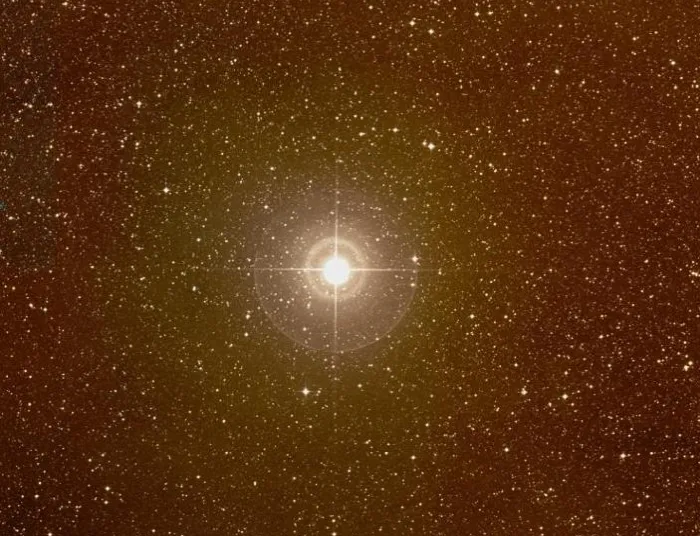
Paikauhale (Tau Scorpii), image credit: ESO/Digitized Sky Survey 2 (CC BY 4.0)
With 14-15 times the Sun’s mass, Paikauhale is destined to go out as a luminous supernova at the end of its life. Depending on their exact mass, its massive older neighbours Antares and Alniyat may go out first.
Astronomers have detected a companion to Tau Scorpii using interferometry, but the secondary component has not been detected using other methods.
Tau Scorpii has an unusually complex magnetic field, one that does not show distinct dipoles. The star’s unusual magnetic topology was first reported in 2006, when a team of scientists led by J.-F. Donati, LATT, Observatoire Midi-Pyrénées, Toulouse, France, reported the discovery of a medium-strength magnetic field on the star. At the time, Tau Scorpii was the third-hottest magnetic star known. Its surface magnetic field was mapped using Zeeman-Doppler imaging.
Astronomers observed the star with the ESPaDOnS spectropolarimeter on the 3.6-m Canada-France-Hawaii Telescope on Mauna Kea, Hawaii. They found temporal variability with a period of around 41 days, attributed to rotational modulation. The variability period corresponds to the star’s rotation period of 41.033 ± 0.002 days. The astronomers concluded that the magnetic field was likely a fossil remnant from the star-formation stage.
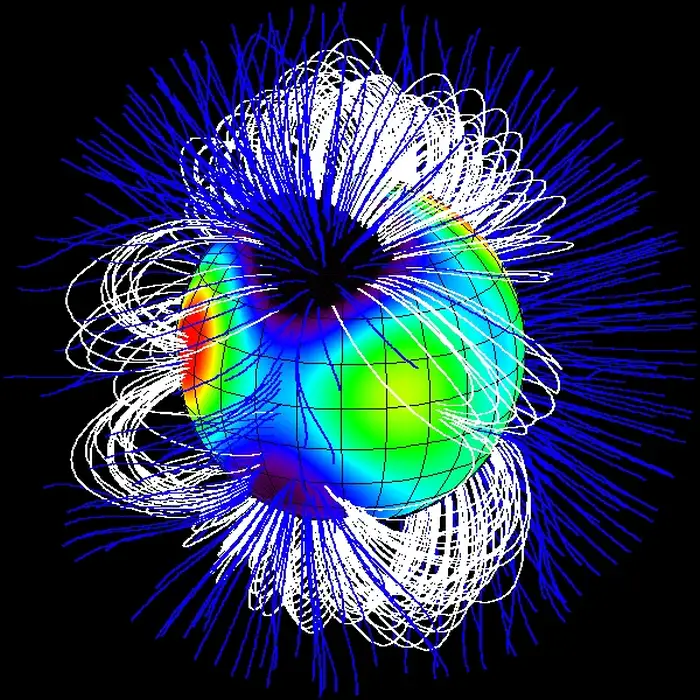
Magnetic map of the massive star τ Scorpii, image credit: Pascalou Petit (CC BY-SA 3.0)
Facts
Paikauhale forms the Fish Hook of Scorpius with Alniyat (Sigma Scorpii), Antares (Alpha Scorpii), Larawag (Epsilon Scorpii), Pipirima (Mu2 Scorpii) and Xamidimura (Mu1 Scorpii), Zeta Scorpii, Eta Scorpii, Sargas (Theta Scorpii), Iota1 Scorpii, Girtab (Kappa Scorpii), and Shaula (Lambda Scorpii). These stars outline the Scorpion’s heart, body, tail and stinger. Antares and Alniyat connect the asterism with the Scorpion’s claws. Both asterisms are easily visible, even from areas with some light pollution.
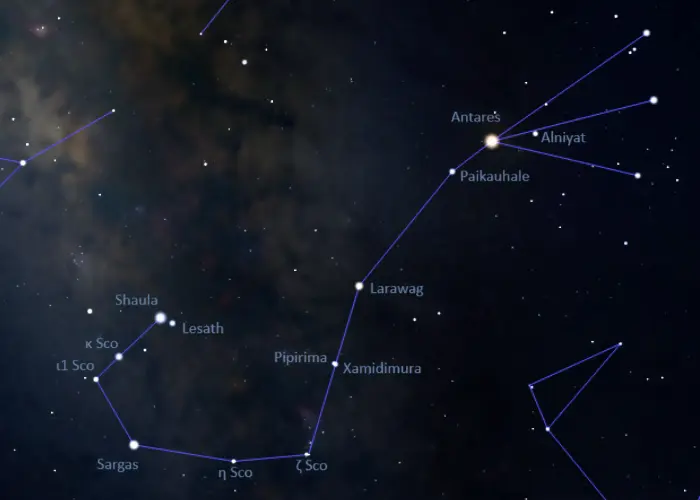
The Fish Hook, image: Stellarium
Tau Scorpii is a member of the Upper Scorpius subgroup of the Scorpius-Centaurus OB association. The Sco-Cen stellar association is the nearest association of massive, blue O- and B-type stars to the Sun. Other bright members include Antares (Alpha Scorpii), Alniyat (Sigma Scorpii), Acrab (Beta Scorpii), Dschubba (Delta Scorpii), and Zeta Ophiuchi.
The members of the Upper Scorpius subgroup have a mean age of 11 million years and lie at an average distance of 470 light years.
Shining at magnitude 2.82, Tau Scorpii is, on average, the 135th brightest star in the sky. It is about as bright as Zeta Herculis in the constellation Hercules, Beta Hydri in Hydrus, Nihal (Beta Leporis) in Lepus, Kaus Borealis (Lambda Sagittarii) in Sagittarius, Algenib (Gamma Pegasi) in Pegasus, and Tureis (Rho Puppis) in Puppis.
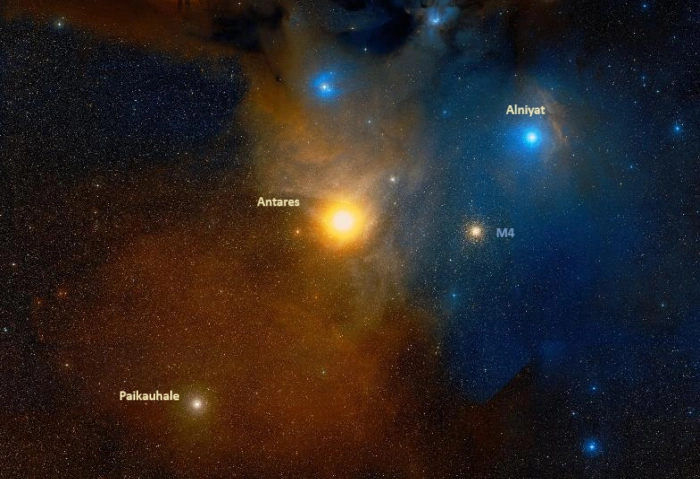
Antares, Alniyat and Paikauhale, image credit: ESO/Digitized Sky Survey 2 (CC BY 4.0)
Name
The name Paikauhale (pronunciation: /ˌpaɪkaʊˈhɑːleɪ/) means “vagabond owning no home,” “to go gadding about from house to house,” or “house-to-house wanderer” in Hawaiian. It is the Hawaiian name for Tau Scorpii. The International Astronomical Union’s (IAU) Working Group on Star Names (WGSN) approved the name on August 10, 2018.
In Hawaiian lore, Au-haele, Hōkū-‘ula and Paikauhale were seen as three stars in a line extending from north to south. The bright Antares (Alpha Scorpii) has been identified as Hōkū-‘ula and Alniyat (Sigma Scorpii) as Au-haele.
Tau and Sigma Scorpii were traditionally known as Al Niyat or Alniyat. The name was derived from the Arabic al-niyāţ, meaning “the arteries.” The two stars flank Antares, the heart of the Scorpion, and represent the Scorpion’s arteries.
In old Chinese astronomy, Tau Scorpii was known as 心宿三 (Xīn Xiù sān), the Third Star of Heart. It formed the Heart asterism with Antares (Alpha Scorpii) and Alniyat (Sigma Scorpii). The asterism represented the heart of the Azure Dragon.
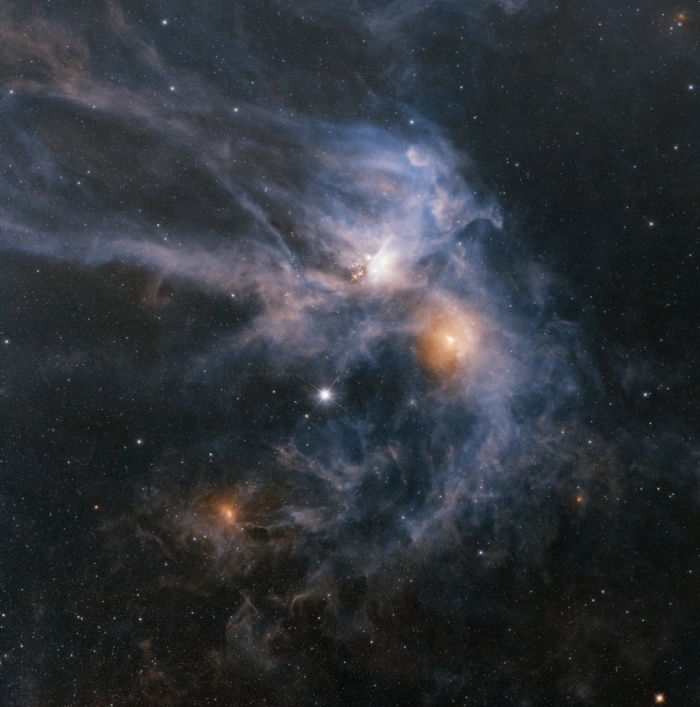
A vast cloud of dust famous for being one of the most colorful and most commonly photographed scenes in the night sky, the Rho Ophiuchi cloud complex takes on a wholly different appearance in infrared light from WISE. Here, where visible light reveals very little, instead silhouetting a dark and mysterious nebula, infrared wavelengths have no trouble piercing this stellar dustbin. In the darkest reaches resides a stellar nursery, shown just above center, which glows intensely with newborn stars and young stellar objects. Just below and to the right of the nursery is a curtain of glowing dust surrounding Sigma Scorpii, appearing reddish in this image. Another smaller curtain of glowing reddish dust is seen surrounding Tau Scorpii to the lower left. The brightest star, appearing white and near center, is nearby Antares. To the lower left one may note the density of the stars is becoming quite high as the Milky Way’s center is approached. At the top, the glow of the zodiacal light is present. Image credit: Judy Schmidt (CC BY 2.0)
Location
Paikauhale is very easy to find because it is relatively bright and part of a familiar asterism, the Fish Hook of Scorpius. It appears near Antares, the 15th brightest star in the sky, in the direction of the Scorpion’s tail. In the Fish Hook pattern, Tau Scorpii is the star between Antares and Larawag.
At declination -28, the star is visible from locations south of the latitude 61° N.
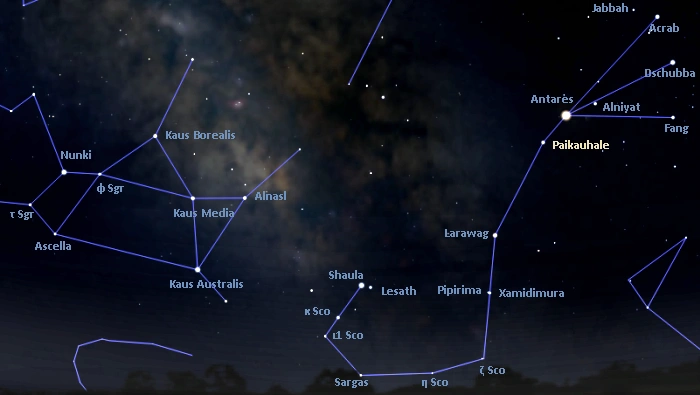
Location of Tau Scorpii (Paikauhale), image: Stellarium
Constellation
Paikauhale is located in the constellation Scorpius. Representing the Scorpion that stung Orion in Greek mythology, Scorpius is one of the Greek constellations catalogued by the Greco-Roman astronomer Claudius Ptolemy of Alexandria in his Almagest in the 2nd century CE. It is one of the 12 zodiac constellations, located on the celestial ecliptic (the Sun’s apparent path across the sky).
Scorpius is the 33rd largest constellation in the sky. It stretches across 497 square degrees of the southern sky between Sagittarius, Ophiuchus, Libra, Lupus, Norma, and Ara. With 13 stars brighter than magnitude 3.0, it is one of the brightest constellations.
Scorpius looks like the animal it represents, which makes it one of the easiest constellations to identify. From the northern hemisphere, it appears above the southern horizon in the evening throughout the summer months.
The constellation is home to the red supergiant Antares, the 15th brightest star in the sky. Antares marks the Scorpion’s heart and appears next to the asterism that represents the Scorpion’s claws. It shines at magnitude 0.6 – 1.6 from a distance of 550 light years.
Like Antares and Paikauhale, many bright stars in Scorpius are supernova candidates, including the blue subgiants Shaula (Lambda Scorpii), Lesath (Upsilon Scorpii), Pipirima (Mu2 Scorpii) and Dschubba (Delta Scorpii), the blue giants Alniyat (Sigma Scorpii) and Kappa Scorpii, the blue main sequence stars Acrab (Beta Scorpii), Fang (Pi Scorpii), Xamidimura (Mu1 Scorpii) and Omega1 Scorpii, the blue hypergiant Zeta1 Scorpii, and the yellow-white supergiant Iota1 Scorpii.
Other notable stars in Scorpius include the yellow-white giant Sargas (Theta Scorpii), the orange giants Larawag (Epsilon Scorpii) and Zeta2 Scorpii, the massive multiple star system Nu Scorpii (Jabbah), the fast nova T Scorpii, the candidate luminous blue variable Wray 17-96 and the blue supergiant Pismis 24-1, both among the most luminous stars known, the variable red supergiant AH Scorpii, one of the largest stars known, and the yellow hypergiant IRAS 17163-3907, the central star of the Fried Egg Nebula (Henize 3-1379).
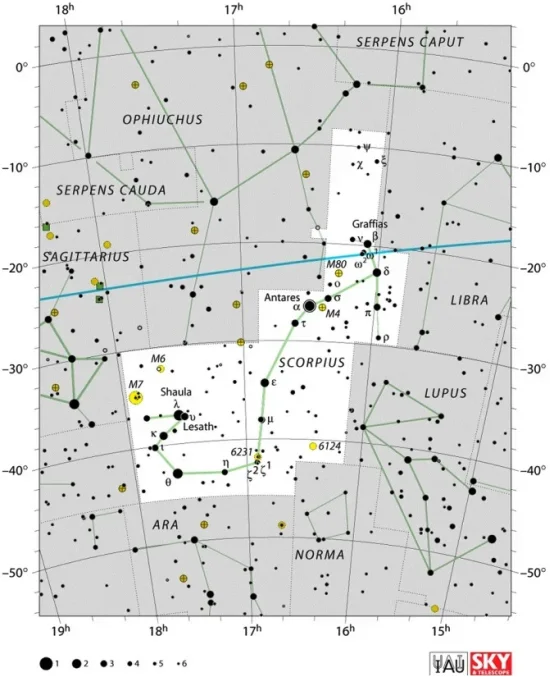
Scorpius constellation map by IAU and Sky&Telescope magazine (Roger Sinnott & Rick Fienberg) (CC BY 3.0)
Scorpius is known for its many bright star clusters and nebulae. Deep sky objects in the constellation include the Northern Jewel Box Cluster (NGC 6231), the Messier open clusters M6 (the Butterfly Cluster) and M7 (the Ptolemy Cluster), the globular clusters M4 and M80, the reflection nebula IC 4592, popularly known as the Blue Horsehead Nebula, the protoplanetary Cotton Candy Nebula, the planetary nebula NGC 6302 (the Butterfly Nebula), and the star-forming nebulae NGC 6334 and NGC 6357, better known as the Cat’s Paw Nebula and the Lobster Nebula.
The best time of the year to observe the stars and deep sky objects in Scorpius is during the month of July, when the constellation appears higher above the horizon in the early evening. The entire constellation can be seen from locations south of the latitude 40° N.
The 10 brightest stars in Scorpius are Antares (Alpha Sco A, mag. 0.6 – 1.6), Shaula (Lambda Sco A, mag. 1.62), Sargas (Theta Sco A, mag. 1.84), Dschubba (Delta Sco, mag 2.307), Larawag (Epsilon Sco, mag. 2.31), Kappa Scorpii (mag. 2.39), Acrab (Beta Sco, mag. 2.62), Lesath (Upsilon Sco, mag. 2.70), Paikauhale (Tau Sco, mag. 2.82), and Fang (Pi Sco, mag. 2.89).
Paikauhale – Tau Scorpii
| Spectral class | B0V or B0.2 V |
| U-B colour index | −1.039 |
| B-V colour index | −0.252 |
| Apparent magnitude | 2.82 |
| Absolute magnitude | -4.2 |
| Distance | 470 ± 40 light-years (150 ± 10 parsecs) |
| Parallax | 6.88 ± 0.53 mas |
| Radial velocity | +2.0 km/s |
| Proper motion | RA: -9.89 ± 0.61 mas/yr |
| Dec.: -22.83 ± 0.55 mas/yr | |
| Mass | 15.0 ± 0.1 M☉; 14.5 – 14.7 M☉ |
| Luminosity | 25,000 L☉ |
| Radius | 6.42 R☉ |
| Temperature | 28,862 K |
| Metallicity | -0.14 dex |
| Age | 5.22 million years |
| Rotational velocity | 24 km/s |
| Rotation | 41 days |
| Surface gravity | 4.24 cgs |
| Constellation | Scorpius |
| Right ascension | 16h 35m 52.9528530s |
| Declination | −28° 12′ 57.661515″ |
| Names and designations | Paikauhale, Alniyat, Al Niyat, Tau Scorpii, Tau Sco, τ Scorpii, τ Sco, 23 Scorpii, 23 Sco, HD 149438, HR 6165, HIP 81266, SAO 184481, FK5 620, CD−27 11015, CPD-27 5427, PLX 3767.10, PPM 265701, GC 22303, GCRV 9538, ALS 14819, SKY# 29892, PMC 90-93 442, HGAM 657, GEN# +1.00149438, GSC 06807-01012, JP11 2775, MCW 561, 1AXG J163553-2813, 2E 3724, 2E 1632.7-2806, EUVE J1635-28.2, N30 3713, SRS 30620, TD1 19318, GES J16355294-2812579, uvby98 100149438, ROT 2361, 1RXS J163553.7-281252, UBV 14025, UBV M 21531, TIC 205175750, WEB 13733, WISEA J163552.94-281258.0, IRAS 16327-2806, 2MASS J16355295-2812576, TYC 6807-1012-1, Gaia DR2 6044420729653939840, Gaia DR3 6044420729667868928 |